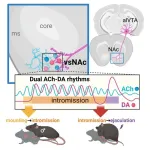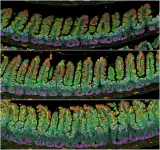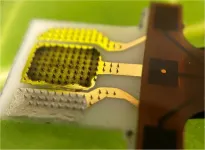(Press-News.org) To uncover what drives sexual behavior in animals, researchers studied the brain activity of male mice throughout the series of actions involved in sex leading up to ejaculation. Their results, publishing in the Cell Press journal Neuron on March 19, show that the intricate dance in the brain area responsible for pleasure between two chemicals—dopamine and acetylcholine—controls the progression of sexual behavior. These findings could inspire treatments for disorders like premature ejaculation.
“Sexual behavior is a complex sequence of events,” says senior author Qinghua Liu of the National Institute of Biological Sciences in Beijing. “The study revealed the dynamics of how different chemicals work together in the brain to regulate the transitions through different stages of male sexual behavior.”
Previous studies of male sexual behavior focused on the initiation of sexual behavior. What exactly happens in the brain during other phases of sex remained unknown, from mounting and intromission—the insertion of the penis into the vagina—to ejaculation.
The nucleus accumbens, a brain region that plays a role in reward, responds to dopamine—a chemical often associated with pleasure. To deepen this knowledge, the team injected florescent sensors that can detect neurotransmitters, the brain’s chemical messengers, into the nucleus accumbens of male mice. An optic fiber would light up if the brain released dopamine and acetylcholine, a neurotransmitter known to regulate dopamine.
The researchers found that mouse brains started to release acetylcholine rhythmically prior to the mounting. About six seconds after acetylcholine release began, the brain also began releasing dopamine. During intromission, the release of acetylcholine and dopamine fluctuated rhythmically in time with the mouse’s thrusting movements. For the mice that reached ejaculation, the dopamine release then slowed down significantly before quickly rising during the transition from intromission to ejaculation.
“We are able to look at these events at a very fine time resolution to understand how neurotransmitters interact with each other,” says first author Ai Miyasaka, a postdoctoral fellow at the University of Tsukuba in Japan.
The researchers also found that the concentration of dopamine played an important role. During intromission, the nerve cells expressing two major dopamine receptors, D2R and D1R, were less active than usual. If the researcher artificially activated D1R cells during intromission, the mice would immediately revert back to the mounting stage. If D2R nerve cells were activated, the mice stopped engaging in sexual activity altogether.
“We uncovered the precise dopamine signaling mechanism that helps ensure that sexual behavior follows the correct sequence,” Liu says.
While mice and humans have different sexual behaviors, the brain regions and neurotransmitter systems involved in sexual function might be similar, note the authors. They suggest that this research could provide new clues to treating sexual dysfunction, particularly premature ejaculation, which affects 20% to 30% of sexually active men.
“Now we have a precise understanding of how dopamine works during sex and ejaculation,” Miyasaka says, “so I believe our study has opened the door to the development of clinical treatments.”
###
This work was supported by financial support from JSPS KAKENHI, JSPS KAKENHI Grant-in-Aid for Scientific Research on Innovative Areas, ‘‘Willdynamics,’’ AMED, the WPI program from Japan’s MEXT, and the New Cornerstone Science Foundation.
Neuron, Miyasaka et al., “Sequential transitions of male sexual behaviors driven by dual acetylcholine-dopamine dynamics.” https://www.cell.com/neuron/fulltext/S0896-6273(25)00080-7.
Neuron (@NeuroCellPress), published by Cell Press, is a bimonthly journal that has established itself as one of the most influential and relied upon journals in the field of neuroscience and one of the premier intellectual forums of the neuroscience community. It publishes interdisciplinary articles that integrate biophysical, cellular, developmental, and molecular approaches with a systems approach to sensory, motor, and higher-order cognitive functions. Visit: http://www.cell.com/neuron. To receive Cell Press media alerts, contact press@cell.com.
END
About The Study: Although access to prescription stimulants is essential to addressing important clinical needs of patients with attention-deficit/hyperactivity disorder (ADHD), this study found that among U.S. adults ages 18 to 64 using prescription stimulants, one-fourth reported misuse, and nearly one-tenth had prescription stimulant use disorder. The findings may suggest potential progress in addressing the mental health care gap for middle-aged women and the need for evidence-based clinical guidance and training on benefits ...
About The Study: There is unlikely to be an increase in the very low incidence of suicide-related adverse events among individuals receiving glucagon-like peptide 1 receptor agonists (GLP-1 RAs) within the context of randomized clinical trials. While these findings may further ease concerns about these adverse effects, continued monitoring is warranted to identify particular patients who may be at risk as extended use of GLP-1 RAs expands.
Corresponding Author: To contact the corresponding author, Sean P. Heffron, MD, MS, MSc, email sean.heffron@nyulangone.org.
To access the embargoed study: ...
Researchers at the Francis Crick Institute have found that the small intestine grows in response to pregnancy in mice. This partially irreversible change may help mice support a pregnancy and prepare for a second.
The organs of many female animals are remodelled by reproduction, but the underlying mechanisms behind the response of the gut to pregnancy have only recently begun to be investigated. For example, scientists previously identified that the fruit fly gut expands during reproduction.
In research published today in Cell, the same team found that pregnant mice had a longer small intestine from just seven days ...
Heavy alcohol consumption is a leading cause of gastrointestinal diseases, with binge drinking linked to increased intestinal permeability—a condition commonly known as "leaky gut." Despite the significant health impact of alcohol-associated gastrointestinal disorders, effective pharmacological treatments remain limited. A new study published in eGastroenterology explores the role of gut cannabinoid receptor 1 (CB1R) in alcohol binge-induced intestinal permeability and reveals how its inhibition can help protect the gut barrier.
The research, conducted by scientists from the National Institute ...
Environmental conditions can cause damaging stress to plants, posing challenges for home gardeners and farmers. Therefore, early detection — before leaves visibly discolor, wilt or wither — is crucial. Now, researchers reporting in ACS Sensors have created a wearable patch for plants that quickly senses stress and relays the information to a grower. The electrochemical sensor attaches directly to live plant leaves and monitors hydrogen peroxide, a key distress signal.
Pests, drought, extreme temperatures and infections all cause stress ...
BUFFALO, NY, March 19, 2025 — For the third year the American Heart Association, a global force changing the future of health for all, and the Buffalo Bills are working together to bring compression-only cardiopulmonary resuscitation (CPR), known as Hands-Only CPR and automated external defibrillator (AED) training and equipment to community events, organizations and youth sports groups across Western New York. Known in the community as the HeartBEAT initiative, this work is adding more people to the ...
CHAMPAIGN, Ill. — Campylobacter infections are the most common foodborne illnesses in the U.S., sickening an estimated 1.5 million people each year. A new study examined records of Campylobacter jejuni infections from 10 states, plotting regional, age-related, and drug-resistance trends from 2013 to 2019.
The study found that drug-resistant C. jejuni infections were highest in the 20-39 age group and that quinolone-resistant C. jejuni infections increased from 22.6% of those tested in 2013 to 33.54% in 2019. The researchers also identified regional differences in C. jejuni resistance to quinolones and six other classes of antibiotics. The new findings are reported in ...
Covering a vast sky area in three mosaics, the data release also includes numerous galaxy clusters, active galactic nuclei and transient phenomena. This first survey data unlocks a treasure trove of information for scientists to dive into and tackle some of the most intriguing questions in modern science. Euclid enables us to explore our cosmic history and the invisible forces shaping our universe.
With its exceptionally large field of view for a space telescope, capturing an area 240 times larger in a single shot than the Hubble Telescope, Euclid delivers outstanding image quality in both the visible and infrared light spectrum.
Crucial contributions from Germany
Euclid is particularly ...
The invasive Pacific oyster have adapted to life in less salty seas and are reproducing off the coast of Skåne, although having been there for less than ten years. This discovery by researchers from the University of Gothenburg suggests that the oysters could colonise the western Baltic Sea in the future.
Pacific oysters were imported to oyster farms in Europe in the 1970s to replace native oysters whose stocks had collapsed. But they quickly began to spread from the farms, reaching northern ...
The latest advance in wearable robotic technology promises to solve a 200-year-old problem by revolutionising the fit of prosthetic limbs, transforming the lives of millions of amputees worldwide.
The new material, ‘Roliner,’ offers amputees the power to change the shape, volume, and stiffness of the liner that is used to attach a prosthetic limb’s socket to a residual leg. Amputees could make these tweaks using their smartphone in real-time, providing a more comfortable and personalised fit.
After eight years of prototype development and clinical investigation, researchers at the Department of Bioengineering at Imperial College ...





